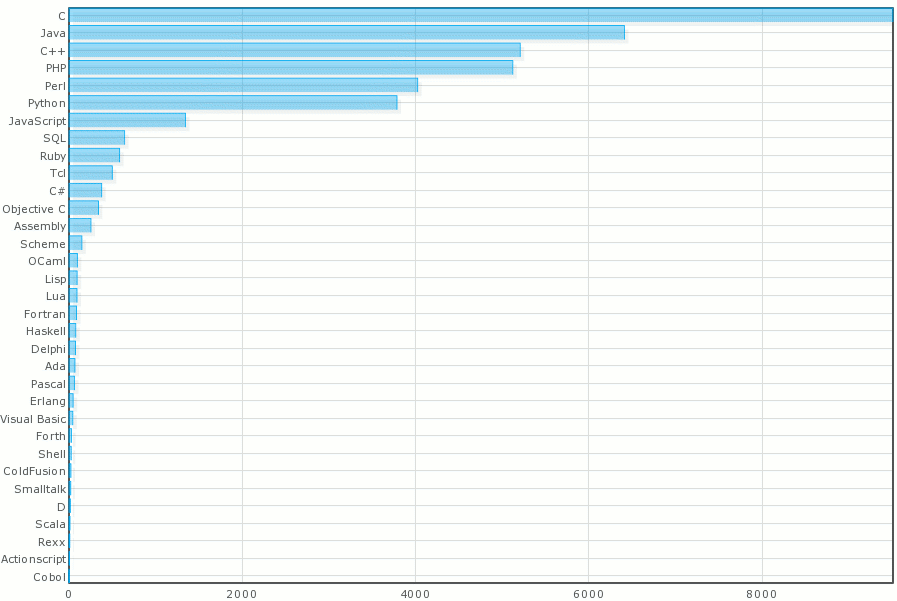- Avoids our need to develop, support, and maintain
unique parsers, compilers, optimizers, debuggers, and general
development environment for a custom language.
Or to port it to the variety of platforms.
This is one of the most significant costs or investments in most tools.
(The cost of re-inventing another compiler/optimizer/debugger/etc..)
- Majority of platforms already support C-language, so
porting / proliferation comes to us for free. Highly portable.
- Training: C and C++ are popular languages, see graph below *. (Even new language developments such as Java are variations on C.)
Chances are, a majority of your staff or recruits already have knowledge and experience in C or C++. No need to train for a new language.
* Freshmeat.net contains information on over a hundred-thousand software applications.
It is a good place to get statistics on real projects that release and maintain working code.
The bar-chart below was obtained from Freshmeat.net's API.
 .
.
See also TIOBE Index - Language Trends.
The C language has been most popular for a long time. And there appear good reasons why it will remain on top
for a long time to come. One reason is that newer languages are tending to compete more with each other, than
to be eroding the long-established ones. Another is the reoccurring and well-meaning trend to create safefty through
restrictions while reducing freedom in methods or styles (ex. Pascall/Ada/Java/C++), in which the long term tendency has
been that the methods which prevail are those allowing the greater creative freedom (ex. C).
- Natural link to existing applications, models, software.
Anything that can be called or done from C can be done in CSIM.
Supports:
- Integration, Hardware/Software co-design,
Application or control code developed within a CSIM model
can be simply lifted and compiled on your embedded processor
for your target application with little manual manipulation.
No language translation needed.
- Multi-level interaction/design/development.
- C nicely supports highly abstract modeling, such as purely mathematical
or functional, and stochastic or analytical modeling, while
also capably supporting low-level detailed digital
design with its standard built-in bit-level operators.
(Even VHDL does not have that!)
- Significant application libraries exist and are freely available to
the CSIM user. For example, graphical, mathematical, analytical
routines and software is available on the world-wide-web from
universities and government. For example, in the mathematical domain,
BLAS-I,II,III, EIG-PACK, LIN-PACK, LA-PACK, various DSP libs,
IMSL, Numerical Recipes, Image processing GIMP, etc..
CSIM is just another package that adds-to, (or multiplies), the
value of R&D that already exists and continues to grow
(critical mass with momentum).
- Feature set - C language has a small set of simple features that are
easily learned and used. It's simplicity and power have lead to its popularity and
wide acceptance, over time when many languages have come and gone.
- Console and file I/O in C is immediately available,
and can be used to print informative messages during development,
while this is limited in most special languages, for example
VHDL, BONes, etc..
- Efficiency. By its very nature, C is very efficient. Also all
known platforms have significant (basically un-matchable)
investment in optimizing C to run most efficiently, reliably, and correctly.
C is compiled, which executes faster than languages that are interpetted at run-time
or otherwise defer and/or reiterate many execution decisions to run-time.
- Many powerful development aids are available (most already come for free!), such as,
interactive symbolic debuggers (gdb, dbx, ddt, etc.), optimizers, grammar checkers (lint),
run-time monitors/profilers (prof, gprof), static analyzers, auto-documentation, etc..
- C is an open ISO standard; not a proprietary language.
This makes CSIM a more standard approach and environment than
tools which are based on closed-end languages.
In comparing your IP (Intellectual-Property) investment in models developed in
a proprietary language tool versus CSIM, the overwhelming majority of your IP
will be captive in the proprietary tool. While, your IP invested
in CSIM models can much more readily be ported to a wider variety of other tools,
environments, and systems.
- Our approach is easily ported to any language. If a new desired language comes along,
we can easily move to whatever language becomes popular, because
we don't care what the language or compiler actually are.
CSIM just passes the user's behavioral code to any compiler.
Only a few small support routines need be ported.
 .
.